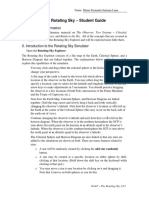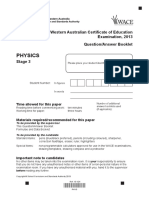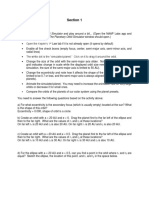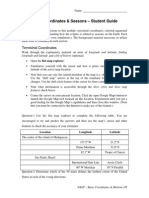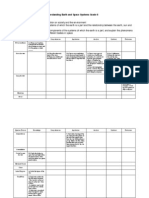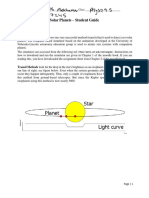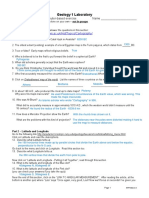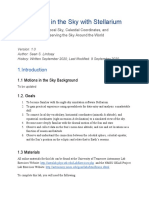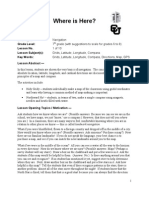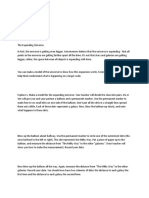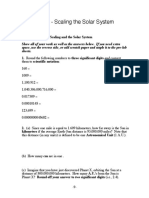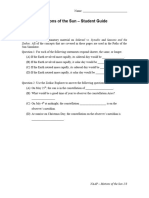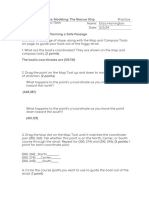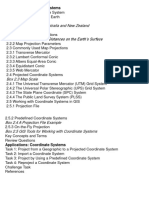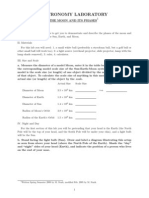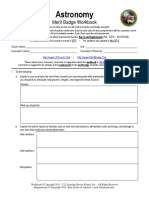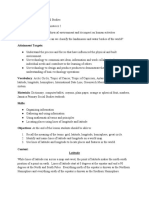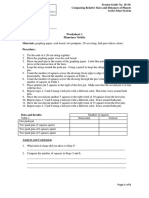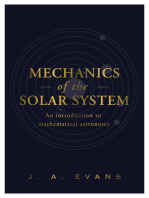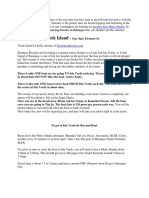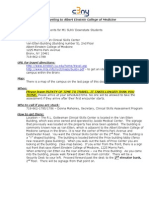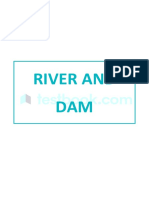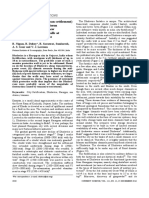Naap Motion1 SG
Naap Motion1 SG
Uploaded by
AceBoogieCopyright:
Available Formats
Naap Motion1 SG
Naap Motion1 SG
Uploaded by
AceBoogieOriginal Title
Copyright
Available Formats
Share this document
Did you find this document useful?
Is this content inappropriate?
Copyright:
Available Formats
Naap Motion1 SG
Naap Motion1 SG
Uploaded by
AceBoogieCopyright:
Available Formats
Name: Aaron Kendall
Basic Coordinates & Seasons Student Guide
There are three main sections to this module: terrestrial coordinates, celestial equatorial
coordinates, and understanding how the ecliptic is related to seasons on the Earth. Each
of these sections has its own simulator(s). The background material necessary to utilize
these tools is contained in each section.
Terrestrial Coordinates
Work through the explanatory material on units of longitude and latitude, finding
longitude and latitude, and a bit of history (optional).
Open the flat map explorer.
Familiarize yourself with the cursor and how it prints out the longitude and
latitude of the active map location.
Note that you can vary the central meridian of the map (i.e. change its
longitude). Use the shift map arrows at the top of the simulator to affect
large rapid changes. Use the shift-click feature of the cursor for finer control.
Note what information is accessible through the show cities and show map
features check boxes.
Center the cursor on your present location. Click the open Google Maps button
to launch the Google Map tool focused on this location. Experiment until you
get a good feeling for the Google Maps capabilities and then close this window.
(Note that you must be connected to the Internet to make use of this feature.)
Question 1: Use the flat map explorer to complete the following table. You are
encouraged to try and predict the answers and then use the maps cursor and other
features to check the accuracy of your estimates.
Location
Longitude
The center of the island of Madagascar. -19.864952 W
North Pacific Ocean
Greenwich, England
Havana, Cuba
Sao Paulo, Brazil
Beijing, China
Latitude
46.446750
157.5 W
21.2 N
Prime Meridian
51.8 N
82.1 W
Tropic of Cancer
23.5500 S
International Date Line
46.6333
W
Arctic Circle
New Orleans
90 W Meridian
30 N Parallel
Question 2: Determine which of the 50 states defines the farthest extent of the United
States in each of the 4 map directions.
NAAP Basic Coordinates & Motions 1/8
Direction
State
North
Alaska
South
Hawaii
East (there are two ways of thinking about
this)
West
Alaska
Alaska
Question 3: The exact coordinates of the white house in Washington D.C., are 77.0365
W and 38.897 N. What are these exact coordinates in sexagesimal notation? Show your
calculation in the box below. (You can use the Google Map tool to check your answer.)
77.0365 = 77 degrees, remainder = 0.0365
0.0365 * 60 = 2 minutes, remainder = .19
0.19 * 60 = 11 seconds
= 77:2:11W
38.897 = 38 degrees, remainder = .897
.897 * 60 = 53 minutes, remainder = .82
.82 * 60 = 49 seconds = 38:53:49N
Open the globe explorer. You are encouraged to use the Terrestrial Coordinate
Explorers link which opens both simulators at the same time for the following two
questions. Familiarize yourself with the features noting that they are very similar
to those in the flat map explorer.
Question 4: A) Where is the North Pole on the flat map explorer? What is its shape?
It is above the United States at the very top of the map. Its shape is flat
B) Where is the north pole on the globe explorer? What is its shape?
The North Pole is located within the Arctic Circle. It is almost circular.
C) Your answers to parts A and B should be different. Explain why.
Each illustration looks different because one is a flat model of the planet and the other is a 3
dimensional model therefore causeing the positioning and the shapes to appear different.
NAAP Basic Coordinates & Motions 2/8
Only two pages have been converted.
Please go to https://pdfburger.com and sign up to convert all pages.
You might also like
- Lab 1Document8 pagesLab 1Tony Lin88% (32)
- Rotating Sky ExplorerDocument11 pagesRotating Sky Explorerapi-3296615530% (5)
- Virginia Studies Reproducible SDocument181 pagesVirginia Studies Reproducible Sanother dba80% (5)
- The Rotating Sky - Student Guide: I. Background InformationDocument13 pagesThe Rotating Sky - Student Guide: I. Background InformationLEONIDAS SANTANANo ratings yet
- Nelson Physics 11Document586 pagesNelson Physics 11Jeff An90% (10)
- Naap Habitablezones SGDocument7 pagesNaap Habitablezones SGTony Lin100% (1)
- Kampala Capital City AuthorityDocument4 pagesKampala Capital City AuthorityAlex NkurunzizaNo ratings yet
- Lab 3 - Measuring Mass of EarthDocument7 pagesLab 3 - Measuring Mass of EarthJacob AltmillerNo ratings yet
- Physics Stage 3 Exam 2013Document40 pagesPhysics Stage 3 Exam 2013gragon.07No ratings yet
- Section 1 & 4fewrDocument6 pagesSection 1 & 4fewrAhmad ZaheerNo ratings yet
- 8417 - U3L8S2 - Building The Solar System Work FileDocument2 pages8417 - U3L8S2 - Building The Solar System Work FileJustin Vernon0% (1)
- Place Value TaskDocument2 pagesPlace Value TaskKaisha MedinaNo ratings yet
- Naap Motion1 SGDocument33 pagesNaap Motion1 SGJudah Szabolcs Nyeky0% (1)
- Linking LabDocument8 pagesLinking Labsavannah0% (2)
- Satellite OrbitsDocument19 pagesSatellite OrbitsPhilip CuetoNo ratings yet
- Module 1 4Document15 pagesModule 1 4AndrewdKiatKiatNo ratings yet
- Lab 2 Exploring The Celestial Globe Using An Online Planetarium Online PDFDocument10 pagesLab 2 Exploring The Celestial Globe Using An Online Planetarium Online PDFKIPNGENO EMMANUELNo ratings yet
- Test Planning FrameworkDocument2 pagesTest Planning Frameworkapi-241274525No ratings yet
- Grade 8 SSDocument14 pagesGrade 8 SSgraff9752No ratings yet
- Exo-Solar Planet Lab Spring 6487245Document4 pagesExo-Solar Planet Lab Spring 6487245joseph.mekhamerNo ratings yet
- Sun and Earth Modern User Reference Guide: Determining earth’s true surface shape as flat using the sunFrom EverandSun and Earth Modern User Reference Guide: Determining earth’s true surface shape as flat using the sunNo ratings yet
- Guia 4. Mov Aparente SolDocument4 pagesGuia 4. Mov Aparente SolAlexa ContrerasNo ratings yet
- Topo Maps Computer Lab - Tagged - NonameDocument3 pagesTopo Maps Computer Lab - Tagged - NonameMichele Aguila-MontesNo ratings yet
- AST 103 Lab2 - Period of Rotation of The Sun LAB MANUALDocument5 pagesAST 103 Lab2 - Period of Rotation of The Sun LAB MANUALjames mwangiNo ratings yet
- Naap Pos SG PDFDocument8 pagesNaap Pos SG PDFWulan Dwi0% (1)
- EPS171 - Lab 3 - Stereonets: PurposeDocument7 pagesEPS171 - Lab 3 - Stereonets: PurposeZamzuri ZaidinNo ratings yet
- 1st SAO (2013) Question PaperDocument10 pages1st SAO (2013) Question PapernguyenchitrungcbnNo ratings yet
- Large Scale Structure of The UniverseDocument29 pagesLarge Scale Structure of The UniverseSetiya RahayuNo ratings yet
- Motions in The Sky Lab v01Document16 pagesMotions in The Sky Lab v01Jun Karren CaparosoNo ratings yet
- Keplers Laws Lab_2024Document11 pagesKeplers Laws Lab_2024tlocrscNo ratings yet
- Sextant ActivityDocument3 pagesSextant ActivityDilip Kumar RaiNo ratings yet
- Kepler's Laws of Planetary MotionDocument4 pagesKepler's Laws of Planetary MotionWorldWideMirNo ratings yet
- Lesson 1Document29 pagesLesson 1Herwan SantosoNo ratings yet
- Ballon ExpansionDocument2 pagesBallon ExpansionNeil Mark MortaNo ratings yet
- Naap SSM SGDocument7 pagesNaap SSM SGchristopher williamsNo ratings yet
- Lab 1 - Solar System ScalingDocument6 pagesLab 1 - Solar System ScalingJacob AltmillerNo ratings yet
- Motions of Sun LabDocument8 pagesMotions of Sun LabBrianThompsonNo ratings yet
- Solution Manual For Mastering ArcGIS 7th Edition Price 007809514X 9780078095146Document11 pagesSolution Manual For Mastering ArcGIS 7th Edition Price 007809514X 9780078095146adamlawsoncnsxmfired100% (33)
- Sun_Earth_Moon_Project_Grade8Document3 pagesSun_Earth_Moon_Project_Grade8u19003464No ratings yet
- Horizon Pre Interview TasksDocument4 pagesHorizon Pre Interview Tasksmanisha.sharma.gnpsNo ratings yet
- Earth Science - ModelsDocument27 pagesEarth Science - Modelssgw67No ratings yet
- Hands-On Science Lesson: A Scale Model of Distance in The Solar SystemDocument7 pagesHands-On Science Lesson: A Scale Model of Distance in The Solar Systemapi-285360604No ratings yet
- Where in The World EntireLessonDocument5 pagesWhere in The World EntireLessonاحمد عبدNo ratings yet
- Exploring Maps - Navigation: How Do We Know Where We're Going?Document5 pagesExploring Maps - Navigation: How Do We Know Where We're Going?Leonte ȘtirbuNo ratings yet
- Projections, Datum, Coordinate Systems, and Units of Measure StandardDocument9 pagesProjections, Datum, Coordinate Systems, and Units of Measure Standardpeter146No ratings yet
- 8 Plate TectonicsDocument10 pages8 Plate TectonicsTayyab AkhlassNo ratings yet
- 3.4.4 Practice - Modeling - The Rescue Ship (Practice)Document3 pages3.4.4 Practice - Modeling - The Rescue Ship (Practice)helloelizajoyNo ratings yet
- Lec02 - Coordinate Systems and Map ProjectionsDocument27 pagesLec02 - Coordinate Systems and Map ProjectionsAdamNo ratings yet
- Astronomy Laboratory: The Moon and Its Phases 1Document6 pagesAstronomy Laboratory: The Moon and Its Phases 1Pradeep Kumar SukumaranNo ratings yet
- PLOTTING POLES AND CONTOURING OF STRUCTURAL GEOLOGY DATA (LAB 4a)Document8 pagesPLOTTING POLES AND CONTOURING OF STRUCTURAL GEOLOGY DATA (LAB 4a)Ahmad Aizat67% (3)
- GravityorbitsphetsimDocument5 pagesGravityorbitsphetsimapi-2518401940% (2)
- Astronomy Merit Badge WorkbookDocument13 pagesAstronomy Merit Badge WorkbookExodusNo ratings yet
- Latitude and World Landmasses.Document27 pagesLatitude and World Landmasses.Arepha FrancisNo ratings yet
- Comparing Relative Sizes and Distances of Planets in The Solar System Worksheets v5Document6 pagesComparing Relative Sizes and Distances of Planets in The Solar System Worksheets v5elizaldeNo ratings yet
- Celestial Calculations: A Gentle Introduction to Computational AstronomyFrom EverandCelestial Calculations: A Gentle Introduction to Computational AstronomyNo ratings yet
- How To Read a Nautical Chart: A Captain's Quick GuideFrom EverandHow To Read a Nautical Chart: A Captain's Quick GuideRating: 4.5 out of 5 stars4.5/5 (7)
- Mechanics of the Solar System: An Introduction to Mathematical AstronomyFrom EverandMechanics of the Solar System: An Introduction to Mathematical AstronomyRating: 5 out of 5 stars5/5 (1)
- Elementary Positional Astronomy Supported by PC Software ProgramsFrom EverandElementary Positional Astronomy Supported by PC Software ProgramsRating: 5 out of 5 stars5/5 (1)
- India 39 S National Parks Tell Me Why 80 gnv64 PDFDocument98 pagesIndia 39 S National Parks Tell Me Why 80 gnv64 PDFanuragNo ratings yet
- A Day of SummerDocument7 pagesA Day of SummerVinz G. VizNo ratings yet
- The Road Ss QuestionsDocument8 pagesThe Road Ss QuestionsMaria HartNo ratings yet
- Solar System and Solar Electricity: Subject Code: EC 38106Document94 pagesSolar System and Solar Electricity: Subject Code: EC 38106Raj TalrejaNo ratings yet
- Paleomagnetism: Curie PointDocument47 pagesPaleomagnetism: Curie PointTyler MroskoNo ratings yet
- Einstein Travel Directions June 2014 GatewaysDocument5 pagesEinstein Travel Directions June 2014 Gatewaysvortex8888No ratings yet
- Magpupungko Beach: 259 ReviewsDocument17 pagesMagpupungko Beach: 259 ReviewsSancai LaderoNo ratings yet
- Conde Nast Traveller UK December 2017Document316 pagesConde Nast Traveller UK December 2017Huan AdrileshNo ratings yet
- Bryophytes of MT Patuha West Java Indonesia-Libre PDFDocument21 pagesBryophytes of MT Patuha West Java Indonesia-Libre PDFladudinNo ratings yet
- Cambio de Uso de La Tierra y Conectividad Biológica en Yungas. D. J. Somma (Wageningen 2006)Document198 pagesCambio de Uso de La Tierra y Conectividad Biológica en Yungas. D. J. Somma (Wageningen 2006)Daniel SommaNo ratings yet
- Oral Literature: and Transmission in The SaharaDocument6 pagesOral Literature: and Transmission in The SaharaslamaNo ratings yet
- Patliputra Extension PresentationDocument16 pagesPatliputra Extension PresentationAnonymous IdctKF6No ratings yet
- Article 1Document19 pagesArticle 1kridatimaNo ratings yet
- Geography - Microsoft OneNote Online-22Document2 pagesGeography - Microsoft OneNote Online-22Richa SinghNo ratings yet
- Hydroelectric EnergyDocument48 pagesHydroelectric EnergyAnne Mel BariquitNo ratings yet
- Islcollective S Talk About Superlatives 140884d7c80f5e67aa1 76647568Document2 pagesIslcollective S Talk About Superlatives 140884d7c80f5e67aa1 76647568Haiber BurgosNo ratings yet
- WEST-BENGAL Tourist Guide PDFDocument12 pagesWEST-BENGAL Tourist Guide PDFgunjanNo ratings yet
- Sequence Stratigraphic Architecture, Evolution, and Geological Controls of An Eocene Isolated Carbonate Platform, NE Sirte Basin, LibyaDocument1 pageSequence Stratigraphic Architecture, Evolution, and Geological Controls of An Eocene Isolated Carbonate Platform, NE Sirte Basin, LibyaSYED TAWAB SHAHNo ratings yet
- River and Dam 13f63970Document27 pagesRiver and Dam 13f63970NayanNo ratings yet
- Post Classical GermanDocument5 pagesPost Classical GermanVirendra PratapNo ratings yet
- Bangka Belitung IslandDocument6 pagesBangka Belitung Islandtheresia herti febyancaNo ratings yet
- The Living Room Stories 2 - Autumn 2019Document26 pagesThe Living Room Stories 2 - Autumn 2019Anonymous Yj0MhizsNo ratings yet
- Dholavira WallsDocument4 pagesDholavira Wallsdarbha91No ratings yet
- Bansal (Definition and Scope of Urban Geo) PDFDocument10 pagesBansal (Definition and Scope of Urban Geo) PDFOwen NaldozaNo ratings yet
- Unit 1 Class 1Document15 pagesUnit 1 Class 1Mr. Ahamed Fazeel Akram B.ArchNo ratings yet
- Indiadividedthir 029134 MBPDocument488 pagesIndiadividedthir 029134 MBPdjpraddyNo ratings yet
- DigitalGlobe Core Imagery Product Guide 0 PDFDocument67 pagesDigitalGlobe Core Imagery Product Guide 0 PDFslamdoNo ratings yet
- Krakatau 6th CenturyDocument48 pagesKrakatau 6th CenturyDomobransky100% (1)



